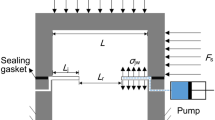Abstract
To investigate the the pull-out behaviors of wedge-grouted rockbolts and grouted rockbolts in strongly weathered and moderately weathered rocks, the rockbolts with lengths of 8.0 m, 10.5 m and 13.0 m were tested under freeze–thaw cycle and cyclic load. The test result shows that the minimum anchoring length of wedge-grouted rockbolt is less than 3.0 m and of grouted rockbolt is less than 4.0 m in the strongly weathered or moderately weathered rock. The effect of the wedge head on restricting the deformation of the rockbolt is not obvious when the anchoring length is less than 6.0 m. Freeze–thaw cycle had little effect on the stiffness and deformation of the two kinds of rockbolts. The wedge-grouted rockbolts have better deformation performance than the grouted rockbolts. The bonding force between the rockbolt and the grout or the grout and the surrounding rock is greater than the tensile strength of the rockbolt. Furthermore, the calculation models of shear stress and axial strain can provide reasonable predictions for two kinds of rockbolts, and the development trends of strain and shear stress under different pullout loads were calculated.











Similar content being viewed by others
Data Availability
The data that support the findings of this study are available from the corresponding author upon reasonable request.
References
Duong-Ngo, H., Do-Tuan, N., & Nguyen-Chau, L. (2020). Retaining system against rockfall near a highway in vietnam-a case study. Lecture Notes in Civil Engineering, 62, 65–869.
Du, J. F., Wang, H. C., Wang, S. Q., Song, X. C., Wang, J. R., & Chang, A. T. (2020). Fatigue damage assessment of mooring lines under the effect of wave climate change and marine corrosion. Ocean Engineering, 206, 107303.
Feng, B., Wang, X., & Wu, Z. S. (2019). Evaluation and prediction of carbon fiber–reinforced polymer cable anchorage for large capacity. Advances in Structural Engineering, 22(8), 1952–1964.
Fujiyama, C., Yonetsu, K., Maeshima, T., & Koda, Y. (2014). Identifiable stress state of wind turbine tower-foundation system based on field measurement and FE analysis. Procedia Engineering, 95, 279–289.
Jimenez-Martinez, M. (2020). Manufacturing effects on fatigue strength. Engineering Failure Analysis, 108, 104339.
Kaiser, P. K., & Cai, M. (2012). Design of rock support system under rockburst condition. Journal of Rock Mechanics and Geotechnical Engineering, 4(3), 215–227.
Li, C. C., & Doucet, C. (2012). Performance of D-bolts under dynamic loading. Rock Mechanics and Rock Engineering, 45(2), 193–204.
Li, Y. Z., & Liu, C. H. (2019). Experimental study on the shear behavior of fully grouted bolts. Construction and Building Materials, 223, 1123–1134.
Ma, Z. Q., Chen, C., Sun, X. M., Wu, G. Y., Liu, P., & Gao, L. (2020). Test and numerical simulation of failure mechanism of barrel and wedge anchorage in coal mines. Construction and Building Materials, 237, 117647.
Makarios, T., & Baniotopoulos, C. C. (2015). Modal analysis of wind turbine tower via its continuous model with partially fixed foundation. International Journal of Innovative Research in Advanced Engineering, 2(1), 14–25.
Morgan, K., Ntambakwa, E., & Hassan, G. (2008). Wind turbine foundation behavior and design considerations. In Proceedings of the AWEA. Wind Power Conference AWEA, Houston, USA.
Nie, W., Guo, W., Ma, S. Q., & Zhao, Z. Y. (2020). Numerical modelling of fully grouted rockbolts subjected to shear load. Rock Mechanics and Rock Engineering, 53(5), 2493–2503.
Pells, P., & Bertuzzi, R. (1999). Permanent rockbolts-the problems are in the detail. In Proceedings, 10th Australian Tunneling Conference, Melbourne, Australia, pp. 21–24.
Stavridou, N., Efthymiou, E., & Baniotopoulos, C. C. (2015). Verification of anchoring in foundations of wind turbine towers. American Journal of Engineering and Applied Sciences, 8(4), 717–729.
Teymen, A., & Kılıç, A. (2018). Effect of grout strength on the stress distribution (tensile) of fully-grouted rockbolts. Tunnelling and Underground Space Technology, 77, 280–287.
Xu, S., Hou, P. Y., Cai, M., & Li, Y. H. (2019). An experiment study on a novel self-swelling anchorage bolt. Rock Mechanics and Rock Engineering, 52(11), 4855–4862.
Yu, S., Niu, L. L. and Chen, J. (2022). Experimental and numerical studies on bond quality of fully grouted rockbolt under confining pressure and pull-out load. Shock and Vibration, 2022.
Zhan, Y. B., Zhang, J., Li, N., et al. (2020). An analytical solution for the critical anchorage length of grouted rockbolts. Arabian Journal of Geosciences, 13(17), 1–11.
Zhang, L., Wang, M., Zhou, H. B., & Chang, X. (2022). Uncertainty quantification for the mechanical behavior of fully grouted rockbolts subjected to pull-out tests. Computers and Geotechnics, 145, 104665.
Zhou, Y. W., Wu, Y. F., & Yun, Y. (2010). Analytical modeling of the bond-slip relationship at FRP-concrete interfaces for adhesively-bonded joints. Composites Part b: Engineering, 41(6), 423–433.
Zou, J. F., & Zhang, P. H. (2019). Analytical model of fully grouted bolts in pull-out tests and in situ rock masses. International Journal of Rock Mechanics and Mining Sciences, 113, 278–294.
Acknowledgements
This work was supported by the National Natural Science Foundation of China Youth Fund (No. 51808100) and the Guidance Plan of Natural Fund of Liaoning Province (No. 2019-ZD_0004).
Author information
Authors and Affiliations
Corresponding author
Ethics declarations
Conflict of interest
The authors declare that they have no known competing financial interests or personal relationships that could have appeared to influence the work reported in this paper.
Additional information
Publisher's Note
Springer Nature remains neutral with regard to jurisdictional claims in published maps and institutional affiliations.
Rights and permissions
Springer Nature or its licensor (e.g. a society or other partner) holds exclusive rights to this article under a publishing agreement with the author(s) or other rightsholder(s); author self-archiving of the accepted manuscript version of this article is solely governed by the terms of such publishing agreement and applicable law.
About this article
Cite this article
Gao, H., Wang, L., Li, X. et al. Experimental Study on Pull-Out Behavior of Wedge-Grouted Rockbolt in Wind Turbine Tower Foundation. Int J Steel Struct 23, 1617–1629 (2023). https://doi.org/10.1007/s13296-023-00793-5
Received:
Accepted:
Published:
Issue Date:
DOI: https://doi.org/10.1007/s13296-023-00793-5




